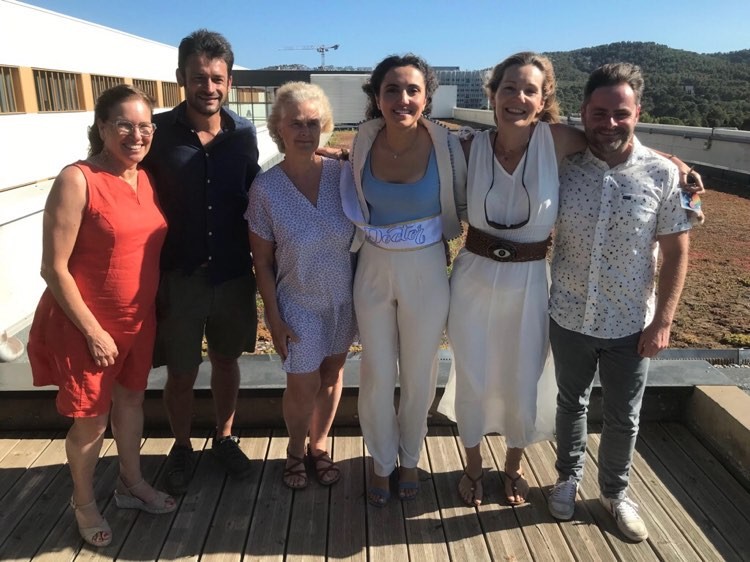Congratulations to Fatima ABABOU (CYBELE) who defended her thesis on July 25, 2023
Title : Role of diazotrophs in the biological carbon pump: study of aggregation, export and remineralization processes

Jury members
Jury
Sophie BONNET Aix-Marseille université
Ilana BERMAN-FRANK Université de Haïfa, ISRAEL
Camila FERNANDEZ Sorbonne université. Laboratoire d'Océanographie Microbienne (LOMIC) - UMR 7621 CNRS-UPMC
M. Frédéric A. C. LE MOIGNE Université de Brest. LEMAR, Laboratoire des Sciences de lEnvironnement Marin, UMR6539, CNRS, UBO, IFREMER, IRD, Plouzané, Technopôle Brest-Iroise, France
Matthieu BRESSAC Laboratoire d'Océanographie de Villefranche, LOV. UMR7093
Mme France VAN-WAMBEKE Aix Marseille université. Mediterranean Institute of Oceanography (MIO).
Guest : Thierry MOUTIN Aix Marseille université. Mediterranean Institute of Oceanography (MIO)
Thesis resume
In the nitrogen-depleted (sub)tropical oceans, occupying ~60% of the global ocean surface, diazotrophs support >50% of new primary production through the fixation of atmospheric nitrogen (N2). This thesis work focuses on the study of the fate of diazotrophs in the ocean, and in particular on the process of aggregation, export and remineralization in order to evaluate their potential role in the biological carbon pump (BCP). The objectives of this thesis were: 1) To study the aggregation and export mechanisms of physically, morphologically and physiologically contrasted diazotrophs. 2) To measure the remineralization rates of the most common diazotroph in (sub)tropical oceans (Trichodesmium) during its sinking to the deep ocean. 3) Identify the composition of the particulate organic carbon (POC) flux exported into an N2 fixation hotspot and determine the contribution of diazotrophs to this flux. (1) A roller tank experiment measured the aggregation rates and sinking velocities of four diazotrophs of contrasting size (1-1000 µm), morphology (filamentous vs. unicellular) and physiology (production of exopolymeric substances, TEP). This study showed that all diazotrophs regardless of size, shape, and physiology formed aggregates of sizes 7000-32014 μm and sink at rates of 92 to >400 m d-1. Unicellular diazotrophs has sinking velocities comparable to filamentous diazotrophs due to their ability to form aggregates in the same size range. In contrast, TEP produced by diazotrophs did not increase their aggregation capacity or sinking velocities, suggesting that their chemical properties may also play an important role in these processes. (2) In a second study in roller tanks, we simulated the sinking of Trichodesmium to a depth of 1000 m in the presence of a natural consortium of heterotrophic bacteria. This study showed that 42% of its derived biomass was still present at the end of the experiment, suggesting incomplete bacterial remineralization and potential sequestration of this biomass in the deep ocean. (3) A third field study conducted in the tropical Southwest Pacific during the TONGA expedition allowed to identify and classify particles exported into the deep ocean. Through image processing, five categories were identified: fecal, phytodetrital and mixed aggregates, cylindrical fecal pellets and zooplankton carcasses. Fecal aggregates were the most abundant, and dominated the POC flux with an average of 56±28% of the total POC flux. Zooplankton carcasses were also abundant and contributed 24±19% to the total POC flux, while cylindrical fecal pellets and mixed aggregates contributed 15±14% and 5±4% respectively. In contrast, phytodetrital aggregates were very low in abundance and contributed <1% to the total POC flux. Estimates of export and transfer efficiencies of all particles combined were significant at 1000 m, showing the ability of the region to effectively sequester POC. Furthermore, confocal microscopy image analyses revealed that the contribution of diazotrophs to POC flux increased from 7% at 170 m to 51% at 1000 m, highlighting the direct export pathways of diazotrophs to the deep ocean and their role in PCB. It is therefore becoming urgent to integrate these pathways into biogeochemical models in order to improve our understanding of their role in PCB in today's ocean and tomorrow's warmer, more stratified and therefore more diazotrophic ocean.

